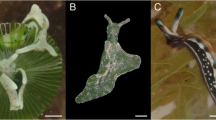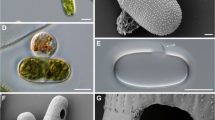Summary
Digestive vacuole formation inTetrahymena pyriformis GL-9 is inhibited by dichloroisoproterenol (dcipr). Inhibition is 95% at 150 μg/ml in starved cells, whereas the same level is achieved by 100 μg/ml in fed cells. The inhibition is rapid and easily reversed by washing the cells, which suggests that it is a surface effect. Dcipr at these concentrations has little, if any, lasting effect upon egestion, although in some cases there is a transient increase in rate for a short period after addition.
Long-term starved (17–19 hours) and short-term starved (3 hours) cells, which had been allowed to form digestive vacuoles for varying periods of time, were then either treated with dcipr, or centrifuged to remove the cells from the suspension medium. These treatments stopped further formation of digestive vacuoles and produced cells with varying digestive vacuolar contents. Throughput times and rates of egestion were examined in the period after cessation of digestive vacuole formation and usually showed lengthening of the throughput times as the initial cellular digestive vacuolar content decreased, coupled with decreased rates of egestion. As far as has been ascertained these results cannot be explained by poorer nutrition due to lower cellular vacuolar contents. They accord with the idea that there is temporal sequencing of digestive vacuolar movement and egestion even when the cellular vacuolar content is low. It is thought that these alterations in throughput times and rates of egestion are largely the resultant of changes in rates of digestive vacuolar movement, rather than reductions in the capacity of the cytoproct to egest. Clearly the cell possesses some mechanism which links the rate of vacuolar movement (and possibly egestion) to cellular vacuolar content. Since cells with continuing vacuole formation show similar throughput times and rates of egestion to cells in which digestive vacuole formation has been stopped at high vacuolar content the linkage must be between vacuolar movement and cellular vacuolar content rather than with vacuole formation itself.
Similar content being viewed by others
References
Berger, J. D., 1971: Kinetics of incorporation of DNA precursors from ingested bacteria into macromolecular DNA ofParamecium aurelia. J. Protozool.18, 419–429.
Borden, D., Whitt, G. S., Nanney, D. L., 1973: Electrophoretic characterization of classicalTetrahymena pyriformis strains. J. Protozool.20, 693–700.
Moran, N. C., Perkins, M. E., 1958: Adrenergic blockade of the mammalian heart by a dichloro analogue of isoproterenol. J. Pharmacol. exp. Therap.124, 223–237.
Powell, C. E., Slater, I. H., 1958: Blocking of inhibitory adrenergic receptors by a dichloro analog of isoproterenol. J. Pharmacol. exp. Therap.122, 480–488.
Rasmussen, L.,Ricketts, T. R., 1977: Endocytosis, exocytosis and lysosomes. Protozoological Actualities. Summary of the Proceedings of the 5th International Congress of Protozoology, New York 1977, pp. 140–146.
Ricketts, T. R., 1970: Effect of endocytosis upon acid phosphatase activity ofTetrahymena pyriformis. Protoplasma71, 127–137.
—, 1971: Endocytosis inTetrahymena pyriformis. The selectivity of uptake of particles and the adaptive increase in cellular acid phosphatase activity. Exp. Cell Res.66, 49–58.
—, 1979: Temporal movement of digestive vacuoles in fedTetrahymena pyriformis GL-9. Protoplasma100, 317–322.
—,Rappitt, A. F., 1976: Endocytosis, digestive vacuolar movement and exocytosis on refeeding starvedTetrahymena pyriformis GL-9. Protoplasma87, 221–236.
Rothstein, T. L., Blum, J. J., 1974: Lysosomal physiology inTetrahymena. III. Pharmacological studies on acid hydrolase release and the ingestion of dimethylbenzanthracene particles. J. Cell Biol.62, 844–859.
Author information
Authors and Affiliations
Rights and permissions
About this article
Cite this article
Ricketts, T.R. Dichloroisoproterenol and digestive vacuolar formation, movement and egestion inTetrahymena pyriformis GL-9. Protoplasma 115, 25–33 (1983). https://doi.org/10.1007/BF01293577
Received:
Accepted:
Issue Date:
DOI: https://doi.org/10.1007/BF01293577




